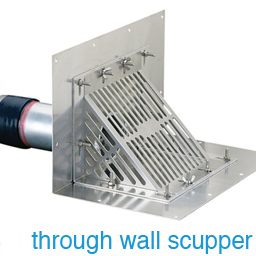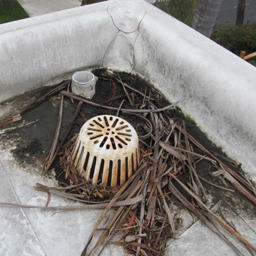The design of your roof system will generally control the movement of water to a specific location of the building. Once at this location the water needs to be removed thru some type of drain system. This Roofing Drain Systems is usually done one of three ways.
Roof Draining
This typically is a unit that has a bowl, clamping ring, strainer and hub that attaches to the drainpipe. The roof is brought over the bowl and the clamping ring is installed to compress and seal the field of the roof to the bowl. Furthermore this is to not allow water under the field of the roof. An internal drainpipe system is attached to the drain bowl and water is carried to the designated location. A strainer is installed on the roof side to prevent debris from entering the drain system. It is important the location and capacity of the drain is adequate for the amount of water it must remove from the roof system.
Thru-Wall Scuppers
This drain system allows water to move off the roof thru an opening in the parapet wall. This opening is water proofed with a fabricated metal scupper that is flashed into the roof system. Once thru the wall to the outside of the building, water is dumped into a leader head. Then it’s funneled into a drainpipe that carries the water to the ground or dry well.
Gutter
A gutter can be a traditional 5” or 6” “K” style gutter or some form of a shop fabricated box gutter. This is used when the roof pitches to the gutter location and water will drop off into the gutter system. Having a gutter that can handle the capacity of the water in heavy rains is crucial. The gutter will overflow if not properly transitioned into a gutter system with an edge metal and flashing. This must be done correctly to avoid water intrusion in to the sealed system.
Whichever drain system your building is equipped with, it is vital to keep the system clean. Clogged drain systems can cause major water intrusion. They could collapse and cause premature failure of the roof system. Clearing drain areas during ice and snow conditions is highly recommended to insure melting snow and liquid can exhaust from the roof area.



